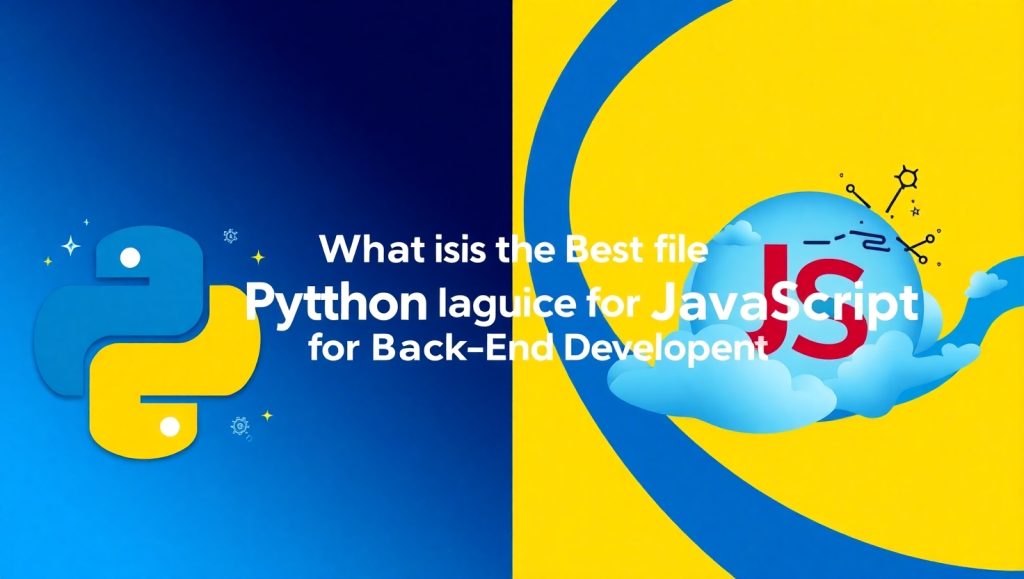
Choosing a backend programming language is like erecting a foundation for a dream-built house-it decides for all that follows. Python versus JavaScript is one of the two strong contenders battling it out in the web development arena. Both have communities, libraries, and frameworks, making them redoubtable tools for building applications in the back end. But which is really the better tool for your project?
This article shall delve into the salient features of the language and analysis concerning back-end development with Python versus JavaScript, accentuating the strengths and weaknesses, and helping you better make up your mind on which is the better fit for you. Critical aspects of the study-inclusion will be learning curve, execution speed, community engagement, and usability-to truly paint a picture.
Understanding Back-End Development
Blackend development is literally the backbone of every web application, as this is where the server, application, and database interact. With the solid back-end support, even the prettiest-looking front-end cannot function.
Back-end developers write APIs, create libraries, interact with system components, and so much more. The choice of back-end language directly affects how fast you can develop features, how secure your system is, and how well it performs under heavy loads.
While deciding between Python or JavaScript, one has to understand that for Python web development, the key frameworks are Django or Flask, whereas, for JavaScript, web development much more refers to Node.js for all server-side activities. It is fair to state that a good choice here will go a long way in determining the efficiency and scalability of your application.
What Makes a Good Back-End Language?
Several key factors define a great back-end language:
- Performance: Can it handle high loads and complex operations quickly?
- Ease of Learning: Is it beginner-friendly?
- Framework Support: Are there robust frameworks available?
- Community and Resources: How active is the community?
- Scalability: Can it grow with your application?
Both Python and JavaScript check many of these boxes, but the way they address each need can be quite different.
Python for Back-End Development

Python is very famous for its simplicity, readability, and versatility. This is the language through which most people learn programming before going ahead into difficult languages. Light curve of learning and helps developers think of solving the problems, removing the syntax fighting process.
There are various frameworks used in Python: Django and Flask are among them. These have a very impressive portfolio for back-end developers. Django usually claims that it is “batteries included.” This means giving everything out of the box to the developer.
One major point about python is less known: it is not greatest for web development but stands alone as the most sought-after language of machine learning, artificial intelligence, and data science. It becomes a very powerful and handy tool in any developer’s toolbox.
Advantages of Python in Back-End
One strong point in favor of using Python is the emphasis on the developer experience. Writing code in Python feels natural, intuitive, and also easily maintainable, to reduce codebase management over time for large teams.
Python also arguably is invaluable for integrating data-laden operations involving traditional back-end and machine learning. This, courtesy libraries like Pandas, NumPy and TensorFlow, makes Python exceptionally strong for mixing traditional back-end and machine-learning workloads.
You’ll find that domain providers, such as Heroku, AWS, and Google Cloud, go a long way to incorporate Python applications in their offerings for ease of deployment.
If you want to get into data-centric web development or AI-enabled web apps, Python would be the way to go.
JavaScript for Back-End Development
In earlier times, JavaScript was simply seen as a language for the browser. That scenario changed when the invention of Node.js enabled the use of JavaScript on the server side too, creating a real paradigm shift.
With JavaScript and Node.js, you can write both front-end and back-end code in the same language. This full-stack feature makes it possible for JavaScript to gain quite a lot in efficiency for teams trying to form a common codebase and bring communication to a reasonable level between front-end and back-end systems.
With popular back-end frameworks such as Express.js, it is easy and swift to create powerful APIs, while the asynchronous nature of JavaScript allows it to efficiently cater to concurrent requests.
Advantages of JavaScript in Back-End
JavaScript’s biggest strength in the back-end world is non-blocking asynchronous I/O. This makes it ideal for applications that require high concurrency, like chat apps, real-time collaboration tools, and streaming services.
Moreover, if your development team is already skilled in front-end JavaScript, extending that knowledge to the back-end with Node.js means less time training and more time building.
JavaScript also benefits from the massive NPM (Node Package Manager) ecosystem. There are millions of ready-to-use packages that can significantly speed up development time.
When building a single-page application (SPA) or a real-time web app, JavaScript is often the preferred choice.
Comparing Python and JavaScript Which One to Choose?
Now that we understand the strengths of both languages, the decision ultimately boils down to your project’s needs, team expertise, and long-term goals.
If your project involves heavy data manipulation, artificial intelligence, or rapid development cycles, Python could be the better choice. On the other hand, if you need to build a scalable real-time application or if you want the convenience of using the same language for front-end and back-end, JavaScript might be ideal.
Key Differences Between Python and JavaScript for Back-End
Here’s a quick comparison:
| Aspect | Python | JavaScript (Node.js) |
| Performance | Good, not ideal for real-time apps | Excellent for real-time applications |
| Learning Curve | Easier for beginners | Moderate, especially async handling |
| Ecosystem | Strong for data science & AI | Strong for web apps & SPAs |
| Scalability | Good | Excellent with microservices |
| Community | Very Large | Very Large |
| Language Usage | Server-side only | Full-stack (front-end & back-end) |
So if your back-end project will also integrate with front-end development services, JavaScript may help you stay consistent across the entire stack.
Conclusion
The truth is, there’s no one-size-fits-all answer. Python and JavaScript both offer amazing capabilities for back-end development — it just depends on what you’re building.
If you’re stepping into data-heavy applications, AI, or if you simply want a cleaner and more straightforward syntax, go for Python. But if you want real-time capabilities, scalable microservices, and seamless integration with front-end frameworks, JavaScript is the better bet.